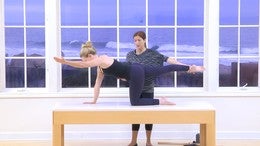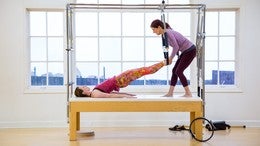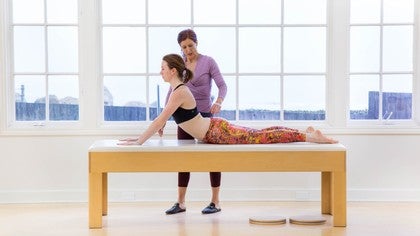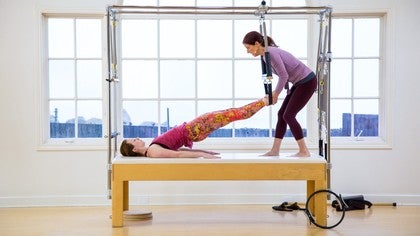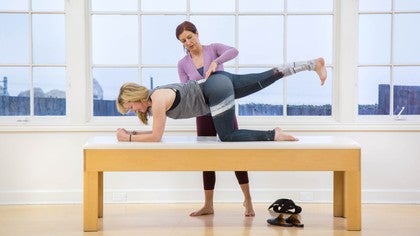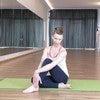Description
Note: This assessment is being done by a licensed physical therapist. Pilates teachers should not try these assessments.
About This Video
Transcript
Read Full Transcript
Okay. Hi, I'm Sherry bets and I'm back again to talk about sacred Iliac joint dysfunction and also known as pelvic girdle dysfunction. A lot of times we think of it as instability or poor control of the pelvis. And we have Shelby from Santa Barbara who is a dancer that's having some pain and I'm going to ask her a few questions about her situation and see what we need to do to assess it before we start to go in and apply some exercises. Um, I'd like to refer you back to the tutorial number 2037 that I did with Amy havens. A, you might want to watch that tutorial as well as this one for some information on sacred ILIAC joint dysfunction. So should all be, thank you for being here. I would love to help you with your situation.
So I'm going to ask you a few questions and I'd love to know what, um, how your pain started and what kinds of things you're experiencing. Um, I get the most pain when I'm sitting for long periods of time or standing for long periods of time. Um, being a dancer, having uh, you know, weeks of rehearsal at a time I get, uh, I get really fatigued through the low back and then that seems to make the whole situation flare up a little bit more. Um, so I'm just, I'm really aware of the imbalances with my, you know, right and left side. And then the pain flares up from there. When I get more fatigue. Is there any dance moves specifically that brings on your pain? Anything that is posterior with that, with that left my left side, that gives me a little more trouble. So anything, uh, behind myself. Um, and what style of dance do you do? Modern.
Okay. Modern. A lot of ballet too. Okay, good. Alright, so I'm going to start with some movements and see how you do with those movements. I'll look at position of your body first, like posturally and then take you through some movements. And my goal is basically to try to provoke her pain or to relieve the pain and see what makes it feel better and what makes it feel worse. I want to know everything that you feel. Okay. And where you feel it. So I'll be specific with that and see if I can help you. Okay. So I'd like you to start by facing the camera and just have your feet about hip width apart and we're going to take a look at her foot alignment first.
And the first thing I noticed about her as I've been watching her in the studio is that she pronates more on the left foot than the right foot and there's a little more internal rotation of the left Femur and a little bit of shift of the ribcage over the pelvis. So you might see that ribcage shifted to one side and you also see a little bit more of the flesh on this left side that points that out. And those are the, some of the things I might be looking at. Um, she also stands, tends to stand in a little bit of hyperextension more on the right than the left and right. I'm not going to make any judgments about that. I don't know why. I know nothing about why at this point. And I don't want to assume just because something is in a certain position that I'm, I understand why it's there. So I just look at what it is and then see when I do more testing what happens.
All right, now please turn around and let's see what she looks like from the back. All right, so we're gonna start at the feet. I like to start at the feet to make sure I know what the foundation is looking like before I go up and going to notice that again. You really see the left pronation, um, more so than the right here. And as I go up, I also see, um, you might not be able to see this on camera, but she has a little bit of atrophy on the left calf more than the right.
Much more. If I were to measure that with a tape measure, I'm sure I would see that there is a difference of maybe on a half an inch to an inch and then, um, left glute is much higher than right. Okay. Don't know why that is just yet. Maybe could be muscle, could be positional of the skeleton. And then, um, if you could bring your pants down a little bit, I know I have to make people get naked for these assessments just about, so, okay, now I've premarked her back so that we can have ease of viewing this. But what I see is very interesting here. Um, even though her left glute is higher than her, right, we see that her left psis is lower than her. Right? So again, I'm just looking at what is, I'm not making any judgments just yet. The psis should be right at the level of s two and that will be the second bump on the sacrum.
And this is a green line here that represents her l five s one segment. And the PSIS is, should be down here actually. So I feel like this is actually in the correct alignment. This may be in the wrong alignment here. And then in relation to the spine, also we're looking at the ILIAC crest height and I look to see if there's a difference there. And it looks to me like the left is higher than the right. Okay.
And then I go straight across from that ILIAC crest and I've marked here the l for segment. So you kind of get a sense of where things are in space and we'll be looking at that as we go along. Okay. Now what I'd like you to do is stand on your right foot back up just a little bit so you can not hit the table. So if you can stand on your right foot for me, I'm going to watch how she weight shifts to the right and lift the left leg. I'm going to watch these dots too, to see how they respond. And then put the left foot down. Stand on the left leg.
That was a little, little less translation to the left. Okay, now stand on the right leg again. Can you rise up on your tippy toe several times? Just up and down. That looks good to me. I'm happy with that. All right, now left side,
Now the next thing I want to look at is, um, I'm gonna have you turn around for me. I'm going to see if she has something called a High Beighton score, which is a hypermobility syndrome. And there's a few different things that we do with that. So the first one is to take your thumb and try to put it on your forearm. So people that are hyper mobile can do that. Okay? So, no, she cannot do that.
All right. Then the other side [inaudible] good. All right. And then your elbows, take them out and see if you can hyper extend your elbows. A little bit of hyper extension there, but it's 10 degrees or more. That would be indicative of the Bayton High Beighton score. And then stand this direction and straightened both knees and try to lock them.
So she has it teeny bit of hyperextension, but definitely not the 10 degrees that's required. So, so far she only has a, maybe a little bit of elbow hyperextension and then um, go ahead and put your palms on the floor for me. Okay. So she definitely gets a one one point for that. Being able to do that indicates, um, one point on that score. So she really only scored a one out of nine, so she does not, I don't think have hypermobility syndrome. Go ahead and come back up now while she's here, I'm going to go ahead and start looking at her lumbar spine cause I'm going to try to figure out, is this a lumbar problem or is this a sciatic nerve problem?
Is this a Piriformis syndrome? Is this acetic joint? I mean, I'm sorry. A secretly act joint problem. All right, so I want you to bend forward rounding from your neck to your low back and you're going to curl forward as much as you can. Okay? And I'm just going to watch how she does that and what I notice. Okay. Come back up and then we're going to turn this direction and let's do it again. Okay. I'm gonna have her bend forward and look and see how she moves.
She's articulating very nicely, very nicely. Oh, the whole chunk here. And then she goes into her hips. So we're going to stop her sooner in the movement. And is that painful at all? No. Okay. All right. Now I'm going to put my hands here and here where her psis is are, and I want to keep, I want you to keep your sacrum and pelvis perfectly still and just round your back. Okay? So start with your neck and round.
Keep going. Keep going. Keep going.
I'm just watching to see what happens there. Good. All right. Now does that, that did not hurt. No. Okay. I'm going to add some overpressure just to make sure. So since she hurts and sitting, I want to see how this goes. All right. Round your back. Okay. I'm going to put my hand on her sacrum and up on her chest and then give her some pressure here. Does that bother you at all? No. Okay. Come back up.
So that doesn't provoke her pain, so she's probably not a disc problem. All right. Now. So I'd been to the right as much as you can. So she has a lot of mobility being a dancer. So does that hurt at all? No. Okay. I'm gonna give you a little over pressure. Okay. And then come back up and then, so I've been left.
Okay. Does that hurt at all? No. Okay. I'm going to give her a little over pressure there. Sorry, I'm in the way. All right. Come back up now. Place your hands on your pelvis and then just kind of like that and then bend backwards. Does that bother you? I do get pain with arching back. Okay. And where? Um, through here? On, right across. Straight across, yeah. Okay.
So she's definitely pointing to the secretly act joint region. All right, now I'm going to hold your pelvis and now rotate to the right twist as much as you can. Use My leverage. And does that hurt at all? No. Okay. And then twist left. Good. Okay. Excellent. So the only thing we know so far is that backward bending does bother this area. And I'm gonna if further sensitize it a little bit.
So take it back and then to the side and I'm going to kind of load that through there. Does that, this is the side that bothers, that really is worse. Okay. And then let's get this way and we're trying to be more specific about the loading of those joints. What about that? I do get pain through this side. Even when you go this way. So whether it's side, right, left or center, she still gets pain. Okay, great. All right, that looks good.
Now let's have you face me and I want you to squat all the way down. Okay? And then come back up. All right. Face the camera and then do it again. And I see what we got here. All right, so I might want to look to see is she symmetrical? How do her feet look? Her feet look pretty good and she does have a little Bunyan on this left side, which I think is probably coinciding with that pronation. Um, but again, um, I'm guessing at that and then come back up. Good. Turn around all the way and then do it again.
I want you guys to see from all angles. Okay. So you'll see that there's no way that somebody can do a full squat, their tailbone two inches from the floor without rounding the lumbar spine. So go as far as you can and we're going to go take it slow, Shelby. And as soon as she passes that kind of parallel to the floor, the back starts to flex. And sometimes that feels good to somebody with secretly Yak problem.
Does that feel good? Yes, it does. Feel good. Okay. And come back up. Excellent. All right. Now we're going to go sit on the mat and I want you to do what's called the slump test. So you're going to sit all the way back and so that your legs are fully supported. Good. Okay. Now slumped downwards. Cause you said you have pain in sitting and do you feel like it's when you start to slump?
So Emily Tuck my pelvis under and kind of sit back like either like this on something. Okay. Or I just, I get numbness through the, through the glute, um, and then pain on a little bit above that side joint that we just found okay. On that side. Okay. Um, so I'm thinking now that it could be like a tractioning of the nerve coming out of there that that pulls on that nerve cause she doesn't have good flection in the lumbar. So maybe being in that prolonged position for a long period of time that that pulls on that nerve a little bit possibly. Um, but there's also the, the component of extension that's bothering you too. So it's a little complicated. So far I don't have a clear understanding of what's happening just yet.
All right. Now I want you to slump downwards and I'm going to keep your shoulder blades over your pelvis. Okay. And then I'm going to add a little pressure. Tell me if that bothers you at all. It's fine. Okay. Now straighten your right leg. Flexture flip back. And does that bother you at all? No, not so much. And that's almost a little, yeah, I feel a little bit of a twinge.
A little bit of a twinge in the little bit. Yeah. Okay. And then come down and then straighten your left leg. Hmm. Yeah, more on this side. Okay. And when did you start to feel it? So I'll kind of measure the angle a lot of times at which they say, okay. Then I'm going to add a little more compression.
So I'm trying to stretch the whole dural sheath from the brain to the ankle. Sladek nerve, spinal cord, all the way from your brain to your foot. Okay. And Are you okay? Okay. So obviously she's not severe in her pain and not, um, irritable. We call it irritable, you know, so not a lot of irritation, so that's good.
All right. That before I definitely felt that. Okay. Not now. Okay, good. All right. Now lay on your back.
So I always try to see am I seeing the same thing in standing that I was seeing that I'm seeing in supine. And then what I also see is that the pelvis is um, rotated forward or anteriorly on the right and post air Leigh on the left. And um, it also looks as if her pelvis is out flared on the right side. So there's definitely not symmetry. And I look at the, the angles of the ribs, the belly button, the two asi s bones, and kind of see if I were to measure those distances, I would get a longer distance between the belly button and the right ass. So there is some asymmetry happening there. Now we can all live with asymmetry.
Not a big deal, but if it start affects, starts affecting our function and pain, then we start to look at that and see if there's something we can do to normalize that alignment. But the main thing is not just getting the alignment correct, it's about getting her function better and her pain down. So I want to use some different tests that we did in standing that extension test and remember those so that when I do her intervention, I'm going to go back and look at those again. Okay. All right. Now we're going to look to see if she has any issues with that nerve as well in this position. So she's in a neutral spine position. I'm going to flex the foot and then do a straight leg raise test.
So I'm going to see if, see I start getting a little bit of tension in the hamstring or in the posterior musculature. Um, maybe the nerve, I don't know if it's nerve or hamstring yet, but I start feeling attention thing called a barrier early on a but no symptoms. Okay. Nothing there. Okay. Now I'm going to take it across, which is going to increase the tension on the nerve and the dural sheath.
I'm trying to reproduce, recreate her familiar symptoms. Want that? Nita? Stay straight.
Now you're starting to get it down through here. You get it down to your foot at all? Not, okay. Not Today, but that's not, so that would be called the cerebral sural bias and then the sural nerve bias and then to get the common peroneal nerve. Yep. Then okay. Yeah. Then we get the side of the [inaudible] does have, now this is not limited in in a normal human body, but in a dancers body, this is limitation. So you start to get that. So she's got something going on with that nerve where it's in trapped and we're going to try to figure out how to free that up. Okay. All right. Now I'm going to go through this sacred ILIAC joint, kind of ruling out that that is the pain generator, right?
We know that the nerve is irritated, but I also want to do the sick early act join and rule that out. So there's a, a battery of tests that's performed and they're called a test cluster and we're going to see which one is provoking pain, if any. Okay. All right. So first one is compression of the secretly act joint bilaterally. Tell me if that bothers you at all. Feels okay. Does it, uh, after you pushed it a little bit more, I felt it. Okay on the left side. Okay. So that would be positive. And then, um, I want you to bend both knees. I'm going to put my hand under your sacrum. [inaudible] go lift your hips. Good.
And then I'm just kind of kind of counterbalance the sacrum and then bring this knee up and then I'm gonna Thrust through that secretly act joint on the left side. Tell me if that bothers you at all. Yeah, there is. It's a little close to the last one. Okay, so same. Okay. All right. Now scoot over all the way to the left and keep going. Okay. Now bring your knee to your chest. This is called the Ganz Lin test. Hold onto your knee or your shin. And then take this leg down.
I'm going to press down through here and tell me if that bothers you. Not so much, actually not so much. No. And then come back up. Bring yourself back to the center of the table. Okay. And then straighten this leg. And this is called the faber test and it just stands for flection, abduction and external rotation. Little Click. Okay.
Turn over and face me and have your hips flexed about 45 degrees. Perfect. Like that. All right. And then I'm gonna come on the top and I'm going to put pressure through her pelvis and see if that, while there's hurt at all. So I have to kind of get my body weight here and push. Okay. Actually I don't feel too bad. No pain. Okay.
Okay. And then, uh, lay on your stomach. Hands under your forehead please. Okay. And then last one is the sacral compression. Anything there? Yeah, left side. Okay. So she's got like five out of the six tests positive. So, um, definitely rules in a secret lack problem.
And I'm gonna work on this secret ILIAC joint. So let's go on. Oh, I'm going to keep you on your stomach. And then I going to test a couple of things while you're here. So I'm going to have you lift your right leg up in the air and then I'm hoping the camera can see that and then come back down. So what you just saw hopefully was that when she extended her right hip, she rotated quite a bit through the lumbar spine and the pelvis as well. Um, I'm looking at that as a motor control issue. Okay. And then lift up again and then hold, hold, hold, hold.
I'm going to look at the strength of that glue. Okay. And then back down and the control of the lumbar spine. All right, now lift up here. She does the same thing. Rotates here as well. And you can see the dots kind of moving around. They shouldn't move at all actually. And then left. So she's strong, but she's not stabilizing the lumbar spine very well. Okay, now I'm going to bend the right knee and let's just see. Great range of motion there. Nothing moving. I'm happy with that.
So her hip flexor is not an issue. It's not pulling on her spine. Now as soon as I start to bend this left knee, her knee sweeps out to the side a lot, quite a bit. So iliotibial band may have something going on there. It's a little bit of motion here. I don't know if you can see that, but she starts to rotate just a little bit towards the end range to the little bit of a hip flexor issue on that left side. Okay, now I'm going to look at her leg length in this position and still seeing left leg long, right? Like short. And then this is called the Deerfield test and I look to see if that changes when I bend her knees and actually it dies.
So she changes from long left to even on the left. So then She's aligned when I've been beneath. So the Tibia is even right, but something's going on between Femur and pelvis. So it's when, when someone has that torsion it what it does, it takes the Acetabulum and and brings it into a different position. So the leg actually looks longer, so she may not have actually a long leg. This is just checking the hip rotators to see if they're even, and they look pretty good there. Are you okay with that? Okay. Now I'm going to have you pull apart into my hands and see how her back her back arches when she does that. And does that hurt at all? No. Okay. Pulled together.
And then that means that that left side could be jammed up into the l five segments. I'm going to check that to see if that's an issue. So I'm going to get in there and, and try to compress that l five s one segment. And does that feel painful? Mm, it's tender. Woking tender, but not saying that, that not huge pain. Huge pain. Okay. I'm going to go up a segment. Mm. Just quickly just ruling out that this is not coming from a disc or lumbar issue, which I don't think so so, but we always have to clear it.
All right, so I'm just putting pressure through those l five s one l for five each fossette compressing the space and seeing if the nerve root is irritated or swollen. It will be problematic and it will send pain down. Okay. All right. So I'm happy with that and I'm just going to palpitate the attachments here of the glutes to the sake room and then the piriformis which goes right across the middle of the buttock. Certainly want to clear that because that could be an issue for her. So in sitting, she's sitting on that side of nerve and so when she sits, it could be that the Piriformis is an issue right there. Yep.
Yeah. So the middle of her buttock is where the performance is and that sometimes in people, the Piriformis is enveloping this attic nerve and that can certainly be a problem that's painful there. So some release work might be helpful there too.
Straighten out your legs and we're going to check to see how her gluteus medius is working. So let's lift the hips up into the air
Go One more time onto your stomach and then push up with your hands to a straight arm position and just let that back extend. Does that hurt at all? No, not today. Okay, so that not today it does hurt sometimes. Sometimes that's interesting. So I'm looking to see if that loaded position is more of an issue for her, which it sounds like it is. It just, she just needs more load to get that thing to be problematic and then come back down. Awesome. All right. Now I'll go ahead and stand up and I want you to hold my hands and um, I want you to do a squat all the way to the ground with one leg. So we already did the two leg squat. We're going to look at one leg squat. So let's do the right side first. Okay. And I'm going to give you support.
So I'm putting my hands under the lumbar spine and trying to touch as many vertebrae as possible. And then I'm going to test the abdominal wall by lifting the right leg up into the air to a 90 degree angle and then the left leg. So nothing should change. Now even when she lifted that second leg, there was a little bit of a lurching forward of the upper lumbar segments. Now I want you to touch the right toe to the floor
Um, she has, um, probably a four out of five strength of the abdominals. So I'm looking at the shape of the wall here. There's not a diastisis there's not a split. And was there pain with that? Like no pain. Okay. So there's an abdominal issue, but I don't think that's her main issue. And when I'm looking at to is to see the of the muscles that are attached to the pelvis, which one is the strongest? Right? The um, hip flexor on your left side has a pole on the, the um, abdominals, have a pull on the pelvis, the glute, your left glutes not working.
So it can't control your pelvis very well. It's working, but not very well. And certainly we saw that in a functional single leg squat. So with the dancer you really have to go a little farther with your challenges to see how they do with that. So now I want you to pick your pelvis up into the air. All right? And then lift one leg.
So I'm really looking to see that she has good stability there and then back down and then lift the other leg. Make sure it doesn't see, that doesn't challenge her, which is why I ended up having to do the standing single leg squat for her and then come all the way back down. Cause normally in, um, people that aren't, um, you know, precision movers like yourself, um, that will, that will bring out a, an issue in the pelvis a lot of times. Okay. So that being said, we're gonna start with some interventions to see if we can help you. Okay. So does that sound good? Have any questions for me? Not right now. Okay. And do you think I've left anything out that is important?
I feel that, um, some knee pain that I get on this side is related to some of this, these issues. I've gotten no actual injury in the knee, but I do get pretty severe pain in the knee sometimes. Ah, okay. From that I feel is from some of that rotation that's happening. Right. And I think that that, that she's probably right on with that because she's got the pronation and that left foot, which can lead to knee pain as well. She doesn't have good proximal control or distal. And so I always think of the knee as the dumb joint in between the foot and the hip because it's just the control of the femur that's going to give you the better alignment and that glute in the back, you know, really having you having good control of the femur and then the pronation of the foot.
So I would definitely work on those two things as well when we try to help your, your back. And I think it's all gonna be, um, it'll be the same approach for all of it and it should help with everything. Okay. Sure. Good. Thank you for adding that. That's great. Yeah. Okay. So what we're gonna do next is, um, try to do an intervention that addresses these issues. Um, we're going to do a mixed equipment workout. It'll involve mat, reformer, trap, trapeze table and chair. And um, see if we can correct some of these imbalances and get your motor control system controlling your pelvis a little bit better knee foot as well. And, uh, we'll do that in the next segment, which will be a mixed equipment workout for the SACROILIAC joint. Perfect. Thank you. Good. You're welcome.
The Teacher's Corner - Playlist 9: Common Back Problems
Comments
You need to be a subscriber to post a comment.
Please Log In or Create an Account to start your free trial.
